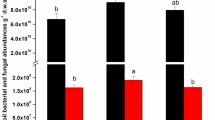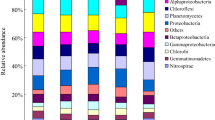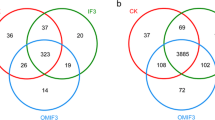Abstract—
Application of mineral fertilizers is an effective way to increase crop yield. It is unclear whether their long-term application can effectively improve soil fungal community composition. In this study, we investigated soil nutrient properties, yield, and soil fungi community composition using ITS rRNA sequencing based on a 38-year wheat–maize rotation field experiment on the Gleyic Cambisols without calcium carbonates. The results showed that long-term application of mineral fertilizer improves soil total nitrogen, organic carbon, available phosphorus and potassium, yield, and fungal community abundance. The predominant fungi divisions changed from Zygomycota in the control check treatment to Basidiomycota and Ascomycota in the mineral fertilizer treatments. Bray-Curtis distances revealed that the fungi varieties were distinctly different among treatments. The fungal community composition was different between nitrogen fertilizer application alone and in combination with potassium fertilizer. The results suggested that the different levels of potassium fertilizer input between nitrogen fertilizer application alone and in combination with potassium might result in different fungal community patterns in the wheat–maize rotation system on the Gleyic Cambisols without calcium carbonates in the North China Plain.





Similar content being viewed by others
REFERENCES
T. M. Bowles, L. E. Jackson, and T. R. Cavagnaro, “Mycorrhizal fungi enhance plant nutrient acquisition and modulate nitrogen loss with variable water regimes,” Global Change Biol. 24, 171–182 (2017).
Y. L. Chen, J. T. Liu, and S. T. Liu, “Effect of long-term mineral fertilizer application on soil enzyme activities and bacterial community composition,” Plant, Soil Environ. 64, 571–577 (2018).
T. I. Chernov and A. D. Zhelezova, “The dynamics of soil microbial communities on different timescales: a review,” Eurasian Soil Sci. 53, 643–652 (2020).
B. Ciccoliniv and E. Pellegrino, “Land-use intensity and soil properties shape the composition of fungal communities in Mediterranean peaty soils drained for agricultural purposes,” Biol. Fertil. Soils 51, 719–731 (2015).
FAO/UNESCO Soil Map of the World Revised Legend with Correlation and Updates, ISRIC Technical Paper no. 20 (International Soil Reference and Information Centre, Wageningen, 1997), pp. 1–140.
N. Fierer, M. A. Bradford, and R. B. Jackson, “Toward an ecological classification of soil bacteria,” Ecology 88, 1354–1364 (2007).
B. J. Finlay, “Global dispersal of free-living microbial eukaryote species,” Science 296, 1061–1063 (2002).
M. S. Girvan, J. Bullimor, J. N. Pretty, A. M. Osborn, and A. S. Ball, “Soil type is the primary determinant of the composition of the total and active bacterial communities in arable soils,” Appl. Environ. Microbiol. 69, 1800–1809 (2003).
D. S. Hibbett, “A phylogenetic overview of the Agaricomycotina,” Mycologia 98 (6), 917 (2006).
X. J. Hu, Response of Soil Microbial Community to Long-Term Fertilization Regimes in Different Black Soil Locations of Northeast China (Northeast Institute of Geography and Agroecology, Chinese Academy of Sciences, Changchun, 2018).
M. R. Islam, P. S. Chauhan, and Y. Kim, “Community level functional diversity and enzyme activities in paddy soils under different long-term fertilizer management practices,” Biol. Fertil. Soils 47, 599–604 (2011).
S. Kasel, L. T. Bennett, and J. Tibbits, “Land use influences soil fungal community composition across central Victoria, south-eastern Australia,” Soil Biol. Biochem. 40, 1724–1732 (2008).
X. Liu, Y. Zhang, and W. Han, “Enhanced nitrogen deposition over China,” Nature 494, 459–462 (2013).
R. K. Lu, Methods of Soil and Agrochemical Analysis (China Agricultural Science and Technology, Beijing, 2000).
P. Luis, H. Kellner, B. Zimdars, U. Langer, F. Martin, and F. Buscot, “Diversity of laccase genes from basidiomycetes in a forest soil,” Soil Biol. Biochem. 36, 1025–1036 (2004).
Q. F. Meng, Q. P. Sun, X. P. Chen, Z. L. Cui, S. C. Yue, F. S. Zhang, T. Müller, and V. Roemheld, “Alternative cropping systems for sustainable water and nitrogen use in the North China Plain,” Agric. Ecosyst. Environ. 146, 93–102 (2012).
F. Oehl, E. Laczko, and A. Bogenrieder, “Soil type and land use intensity determine the composition of arbuscular mycorrhizal fungal communities,” Soil Biol. Biochem. 42, 724–738 (2010).
T. Schneider, K. M. Keiblinger, E. Schmid, K. Sterflinger-Gleixner, G. Ellersdorfer, B. Roschitzki, A. Richter, L. Eberl, S. Zechmeister-Boltenstern, and K. Riedel, “Who is who in litter decomposition? Metaproteomics reveals major microbial players and their biogeochemical functions,” ISME J. 6, 1749–1762 (2012).
M. V. Semenov, D. A. Nikitin, A. L. Stepanov, and V. M. Semenov, “The structure of bacterial and fungal communities in the rhizosphere and root-free loci of gray forest soil,” Eurasian Soil Sci. 52, 319–332 (2019).
A. Sessitsch, A. Weilharter, M. H. Gerzabek, H. Kirchmann, and E. Kandeler, “Microbial population structures in soil particle size fractions of a long-term fertilizer field experiment,” Appl. Environ. Microbiol. 67, 4215–4224 (2001).
X. Z. Sh, D. S. Yu, W. X. Sun, H. J. Wang, Q. G. Zhao, and Z. T. Gong, “Reference base study of Chinese and American soil classification systems: reference between soil classes and American soil classes,” Sci. Bull. 49, 1299–1303 (2004).
D. L. Song, X. Y. Xi, Q. Zheng, G. Q. Liang, W. Zhou, and X. B. Wang, “Soil nutrient and microbial activity responses to two years after maize straw biochar application in a calcareous soil,” Ecotoxicol. Environ. Saf. 180, 348–356 (2019).
X. Y. Song, S. T. Liu, Q. H. Liu, W. J. Zhang, and C. G. Hu, “Carbon sequestration in soil humic substances under long-term fertilization in a wheat-maize system from North China,” J. Integr. Agric. 13 (3), 562–569 (2014).
M. S. Strickland and J. Rousk, “Considering fungal: bacterial dominance in soils-methods, controls, and ecosystem implications,” Soil Biol. Biochem. 42, 1385–1395 (2010).
R. Sun, M. Dsouza, and G. Jack, “Fungal community composition in soils subjected to long-term chemical fertilization is most influenced by the type of organic matter,” Environ. Microbiol. 18, 5137 (2016).
X. Y. Sun and F. W. Xiang, “Semi-aqueous soil and aqueous soil”, in Soil Resources Science, Ed. by X. Y. Cui, (China Forestry Press, Beijing, 2007), pp. 201–217.
V. A. Tamayo and N. W. Osorio, “Co-inoculation with an arbuscular mycorrhizal fungus and a phosphate-solubilizing fungus promotes the plant growth and phosphate uptake of avocado plantlets in a nursery,” Botany 95, 539–545 (2017).
S. R. Vimal, J. S. Singh, N. K. Arora, and S. Singh, “Soil-plant-microbe interactions in stressed agriculture management: a review,” Pedosphere 27, 177–192 (2017).
H. Y. Wang, M. G. Xu, B. K. Zhou, X. Ma, and Y. H. Duan, “Response and driving factors of bacterial and fungal community to long-term fertilization in black soil,” Sci. Agri. Sin. 51, 914–925 (2018).
J. C. Wang, Y. Song, T. Ma, W. Raza, J. Li, and J. G. Howland, “Impacts of inorganic and organic fertilization treatments on bacterial and fungal communities in a paddy soil,” Appl. Soil Ecol. 112, 42–50 (2017).
H. Z. Yuan, T. Ge, P. Zhou, S. L. Liu, P. Roberts, H. H. Zhu, Z. Y. Zou, C. L. Tong, and J. S. Wu, “Soil microbial biomass and bacterial and fungal community structures responses to long-term fertilization in paddy soils,” J. Soil. Sed. 13, 877–886 (2013).
F. S. Zhang, Z. L. Cui, X. P. Chen, X. T. Ju, J. B. Shen, Q, Chen, X. J. Liu, W. F. Zhang, G. H. Mi, M. S. Fan, and R. F. Jiang, “Integrated nutrient management for food security and environmental quality in China,” Adv. Agron. 116, 1–40 (2012).
Funding
This work was supported by the National Key Research and Development Program of China (numbers 2017YFD0301002 and 2018YFD0300604), the High-level Personnel Scientific Research Funds of Qingdao Agricultural University (number 1118008), and the Shandong Province modern agricultural industry technology system construction funds (number SDAIT-02-06).
Author information
Authors and Affiliations
Corresponding author
Ethics declarations
No potential conflict of interest was reported by the authors.
Rights and permissions
About this article
Cite this article
Yanling Chen, Cao, Y. & Liu, S. Effects of Long-Term Mineral Fertilizer Application on Soil Nutrients, Yield, and Fungal Community Composition. Eurasian Soil Sc. 54, 597–604 (2021). https://doi.org/10.1134/S1064229321040049
Received:
Revised:
Accepted:
Published:
Issue Date:
DOI: https://doi.org/10.1134/S1064229321040049




